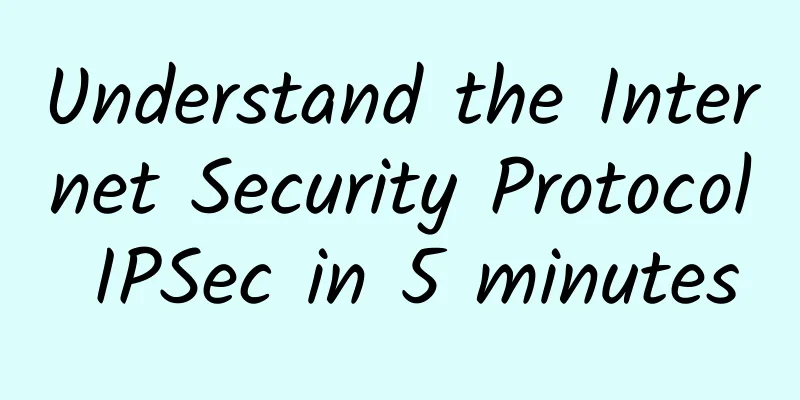Understand the Internet Security Protocol IPSec in 5 minutes

|
There are thousands of networks, but security is the most important. As the scale and complexity of networks increase, the transmission security of the underlying network becomes very important. Both parties in communication need a method that truly provides security at the IP layer to ensure that the data sent and received is secure. IPSec (Internet Protocol Security) does this.
IPSec is a collection of protocols and services that provide complete security for IP networks, and can provide transparent security services for upper-layer protocols and applications. The so-called transparency means that users cannot perceive the entire IPSec working process. This is very nice, as it ensures user data security without causing any trouble to users. Having said so much, what protocols and services does IPSec include? What are their functions? IPSec is a collection of IP security protocols and an architecture consisting of AH and ESP protocols, encryption and authentication algorithms, key management, and security negotiation. IPSec provides a secure channel for devices at both ends of the communication. The devices can be hosts, routers, or firewalls. AH ProtocolAH (Authentication Header) refers to a message authentication code that has been calculated before sending the IP packet. The sender calculates AH with an encryption key, and the receiver verifies it with the same or another key. AH has two working modes: transport mode and tunnel mode.
ESP ProtocolESP provides confidentiality and optional authentication services, encrypting user data that needs to be kept confidential and then encapsulating it into a new IP packet. ESP has two modes: transport mode and tunnel mode.
Encryption and authentication algorithmsData confidentiality is the primary requirement for any virtual private network. Current encryption and authentication algorithms fall into two categories: symmetric and asymmetric. Symmetric algorithms are based on the fact that the sender and receiver of data have the same key. The sender uses the key to encrypt the data, and the receiver uses the same key to decrypt the data. Asymmetric algorithms are also called public key algorithms. Different keys are used for encryption and decryption. The encryption key is called the public key and can be made public. The encrypted data can only be decrypted with the private key, which is kept secret. Anyone with the recipient's public key can encrypt data, but the data can only be decrypted with the recipient's private key. Secure negotiation and key managementBefore using AH or ESP, a logical connection at the network layer must be established between hosts. This logical connection is called security negotiation, or SA (SECURITY ASSOCIATION). Security negotiation SA can be established manually or using the IKE protocol. SA is a one-way connection. If two-way secure communication is required, two SAs need to be established. There are two types of SA: IKE (Internet Key Exchange, Automatic Key Management Protocol)/ISAKMP SA and IPSec SA.
The default automatic key management protocol for IPSec is IKE. The main task of the IKE protocol is to establish and maintain ISAKMP SA and IPSec SA. The IKE protocol uses two phases to establish ISAKMP SA and IPSec SA respectively.
Now everyone should have mastered it! |
<<: Nine global manufacturers using 5G
Recommend
[Black Friday] Tudcloud: Hong Kong VPS annual payment up to 40% off, recharge 30%
Tudcloud offers a big discount on annual payment ...
Potential application scenarios of 6G in the future
Although 6G is not yet a viable technology, it wi...
Should you upgrade your 5G package? Read this article before deciding
Recently, I often receive such calls on my two mo...
How do these countries plan their 5G breakthrough amid the COVID-19 crisis?
5G is a new technology field that all countries a...
HostYun: Hong Kong high bandwidth VPS monthly payment starts from 18 yuan, single core/1G memory/10G SSD/50M port
Let me share some information about HostYun's...
Explore Java application startup speed optimization
[[418030]] 1. Can you have both high performance ...
Enterprises need to prioritize mobile unified communications
The need for secure, reliable, and easy-to-use co...
5G is coming. How long can 4G hold out? Will WiFi still have the last laugh?
The mobile phones in Carmen, Mong Kok seem to hav...
Experts talk about 5G development: If 5G wants to explode, the industry chain still needs to work hard
At present, 5G has become an important engine for...
Deutsche Telekom CEO blasts OTT: generating 80% of traffic but not paying a penny for infrastructure
According to Mobile World Live, Deutsche Telekom ...
A Preliminary Study on Software Defined Network (SDN)
【51CTO.com Quick Translation】Before 2008, the ent...
618 is here, it’s time to upgrade your WiFi 6 router!
[[404856]] 618 is here, and during the annual sho...
Donghua's anti-unified prescription system helps hospitals develop an "indestructible body"
Recently, a piece of news that "Apple China ...
China's 5G connections have reached nearly 430 million, accelerating the exploration of vertical application markets
By the end of 2021, nearly 8% of the world's ...
CloudCone: $17/year-dual-core/1GB/55GB/2TB@1Gbps/Los Angeles data center
Here is some information about CloudCone's re...









